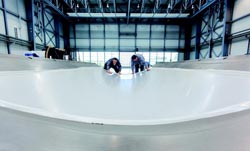Release agent free demolding of components & heat and electricity conducting composite material

Release agent free manufacture of very large components: Checking the deep-drawn fold-free FlexPLAS® release film on the mold for a CFRP aircraft fuselage section (© Fraunhofer IFAM).<br>
Focus will also be put on a new polymer-metal composite material which is suitable for the structural monitoring of components or for seawater desalination applications.
Effective and residue-free demolding, as well as coating
It is a process that is repeated hundreds of thousands of times a day in industry on a small scale: A component is manufactured using a mold and thereafter removed from the mold. New technologies from Fraunhofer IFAM, namely FlexPLAS® release films and ReleasePLAS® mold coating technology, allow effective demolding of components without the need to use release agents.
The FlexPLAS® release film technology was awarded the “AVK Innovation Prize 2012” and the “Composite Innovations Award 2013”. Features of these films are their extreme elasticity and durability. They can be stretched with little force and can even withstand extreme elongation of up to 300 percent without functionality impairment. This is ideal for fold-free application, even on curved or structured molds. The films can also be used manufacturing very large components made of fiber reinforced plastics (FRPs).
Following demolding, the components can be immediately coated without the need for complex pre-treatment. This is because there is no transfer of materials from the release film, meaning no costs are incurred removing contaminants or residues of release agents. The new technology also allows the in-mold coating of fiber composite components: This process is relatively easy and involves applying a gel coat to the FlexPLAS® release film. The degree of matt/gloss of the coated surface can be adjusted via the roughness of the FlexPLAS® release film that is employed. This coating technique significantly lowers the risk of coating defects. The production of the FRP component itself takes place on top of the coating. The in-mold coating and FRP component are cured together and the coated component with the release film is then removed from the mold. If the release film is kept on the component to the end of the manufacturing process or until delivery to the final customer, then it also serves as a protective film.
In contrast, the ReleasePLAS® coating is applied directly to the mold. It perfectly matches the surface structure and its properties can be adapted to various customer-specific requirements.
New composite material conduct heat and electricity
The new material is a mixture of plastic and metal, namely a “polymer-metal composite”. A wide range of polymers can be used as the matrix material for the composite. The material can therefore be readily customized for specific applications. Other advantages: The material is easy to process because of his plastic character. It is also light and conducts electricity and heat very effectively due to the high metal content.
The composite material is ideal for the structural monitoring of load-bearing components. When a component is exposed to loads, the electrical resistance of the composite changes. These signals can be transmitted via a cable on the component and then analyzed by a measuring instrument. The composite material is used in the form of heat-conducting pipes for seawater desalination. The principle of desalination: Seawater is sprayed onto pipes through which hot gas or water flows, so heating the pipes. Pure water evaporates from the seawater leaving behind a salty waste liquor.
Contact
K 2013 I October 16-23, 2013 I Düsseldorf I Germany
Hall 07 I Stand B05
Media Contact
More Information:
http://www.ifam.fraunhofer.deAll latest news from the category: Trade Fair News
Newest articles

Parallel Paths: Understanding Malaria Resistance in Chimpanzees and Humans
The closest relatives of humans adapt genetically to habitats and infections Survival of the Fittest: Genetic Adaptations Uncovered in Chimpanzees Görlitz, 10.01.2025. Chimpanzees have genetic adaptations that help them survive…

You are What You Eat—Stanford Study Links Fiber to Anti-Cancer Gene Modulation
The Fiber Gap: A Growing Concern in American Diets Fiber is well known to be an important part of a healthy diet, yet less than 10% of Americans eat the minimum recommended…

Trust Your Gut—RNA-Protein Discovery for Better Immunity
HIRI researchers uncover control mechanisms of polysaccharide utilization in Bacteroides thetaiotaomicron. Researchers at the Helmholtz Institute for RNA-based Infection Research (HIRI) and the Julius-Maximilians-Universität (JMU) in Würzburg have identified a…



